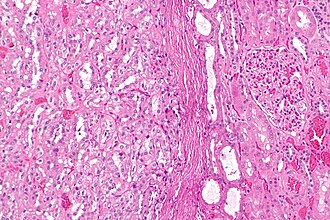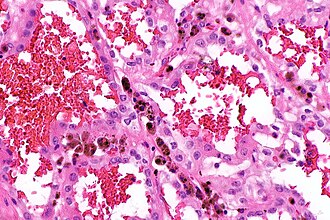Birt–Hogg–Dubé syndrome
Birt–Hogg–Dubé syndrome, also Hornstein-Birt-Hogg-Dubé syndrome,[1] is constellation of findings due to a FLCN (folliculin) gene mutation.[2] It is abbreviated BHD syndrome.
Features
BHD syndrome is characterized by:[3][4]
- Skin lesions of face, neck and anterior trunk (~80% of individuals with syndrome):
- Fibrofolliculoma.
- Trichodiscoma.
- Acrochordon.
- Renal tumours (~25-35% of individuals):
- Variable penetrance (autosomal dominant).
- Lung cysts - inferior to carina (~80% of individuals with syndrome)).
- Multiple basal lung cysts - may be significant.[6]
- Spontaneous pneumothorax (~25% of individuals with syndrome).[4]
Note:
- May be seen with a mix of oncocytic renal tumours - known as renal oncocytosis.
See also
References
- ↑ Happle, R. (Jun 2012). "Hornstein-Birt-Hogg-Dubé syndrome: a renaming and reconsideration.". Am J Med Genet A 158A (6): 1247-51. doi:10.1002/ajmg.a.35330. PMID 22581760.
- ↑ Online 'Mendelian Inheritance in Man' (OMIM) 135150
- ↑ Humphrey, Peter A; Dehner, Louis P; Pfeifer, John D (2008). The Washington Manual of Surgical Pathology (1st ed.). Lippincott Williams & Wilkins. pp. 290. ISBN 978-0781765275.
- ↑ 4.0 4.1 Furuya, M.; Yao, M.; Tanaka, R.; Nagashima, Y.; Kuroda, N.; Hasumi, H.; Baba, M.; Matsushima, J. et al. (Nov 2016). "Genetic, epidemiologic and clinicopathologic studies of Japanese Asian patients with Birt-Hogg-Dubé syndrome.". Clin Genet 90 (5): 403-412. doi:10.1111/cge.12807. PMID 27220747.
- ↑ Hes, O.; Petersson, F.; Kuroda, N.; Hora, M.; Michal, M. (Oct 2013). "Renal hybrid oncocytic/chromophobe tumors - a review.". Histol Histopathol 28 (10): 1257-64. PMID 23740406.
- ↑ Johannesma, PC.; Houweling, AC.; Menko, FH.; van de Beek, I.; Reinhard, R.; Gille, JJ.; van Waesberghe, JT.; Thunnissen, E. et al. (Apr 2016). "Are lung cysts in renal cell cancer (RCC) patients an indication for FLCN mutation analysis?". Fam Cancer 15 (2): 297-300. doi:10.1007/s10689-015-9853-5. PMID 26603437.

